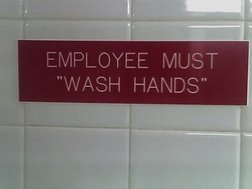 We'll start with the primary jobs for which quotation marks are excellent: The obvious one is when presenting an exact quotation -- "To be or not to be," is one of the most famous lines ever written. When a quote falls within a quote, single marks are used for the inner statement -- He told her, "be careful, or I might have to go all, 'Frankly, my dear, I don't give a damn!'" In this context, quotation marks are used in writing dialogue. The trouble with quotation marks, as in the photographs here, comes with their use to indicate euphemism, irony or sarcasm. Instead of quotation marks, one could use words like "supposedly" or "so-called" -- as in, She was "feeling ill" and left early versus She was supposedly feeling ill, and left early You can appreciate the similarity, while the first one is probably a more effective statement of the dubiousness with which the speaker/writer views the claim of illness.  Which brings us back to the problem at hand. We frequently encounter the clear error of using quotation marks to indicate emphasis -- often with slightly comedic (or disconcerting) results. We're not quite certain how this situation has grown to epidemic proportions, but it has. To emphasize a word or statement (often a rule, regulation or command), one has quite a few tools in the typographical arsenal: italics, boldface, underlining, ALL CAPITALS or ANY COMBINATION of the foregoing. So, there is no shortage of options. Re-purposing of quotation marks to create another one is not only wrong, it's unnecessary. Though the intended meaning in a statement containing errant quotation marks is understood, the essence result suggests the opposite.
0 Comments
|
Write and Polish BloggersChristie Manussier, principal Writer and Polisher, is the usual news reporter. CategoriesAll Abbreviation Academic Acronym Adjective Adverb Anachronism Anagram Apostrophe Application Article Banished Biography Blend B.N.I. Boldface Brochure Bunnies Business Business Plan Capitalization Children's Literature Christmas Church Comma Common Mistakes Construction Contact Management Content Contest Cross-sell Databse Differentiators Donation Double Negative E-mail Entertainment Etymology Event Coordination File Format First Reference Flyer Fundraiser Giggles Gold Star Grammar Day Grant Proposal Haiku Health Care Homophones Hyphen Idiom Images Italics Law Firm Magazine Manual Marketing Maternity Leave Metaphor Myth News & Announcements Newsletter Non Profit Non-profit Noun Numbers Of Snakes And Presidents Parts Of Speech P.D.F. Plural Poetry Portmanteau Poster Powerpoint P.R. Preposition Press Release Projects Pronoun Proofreading & Editing Punctuation Quotation Marks Quotes Real Estate Recommended Reading Reflexive Research Resources Restaurant Retail R.F.P. R.I.P. Shakespeare Slideshow Social Media Spelling Style Manual Synonyms Syntax Template Tenses Testimonial Thesaurus Training Manual Translation Travel Twitter Underlining Verb Video Vocabulary Website Why The World Needs More Proofreaders Winter Word Of The Day Writers Writing Tip Archives
March 2015
|
Search by typing & pressing enter

 RSS Feed
RSS Feed